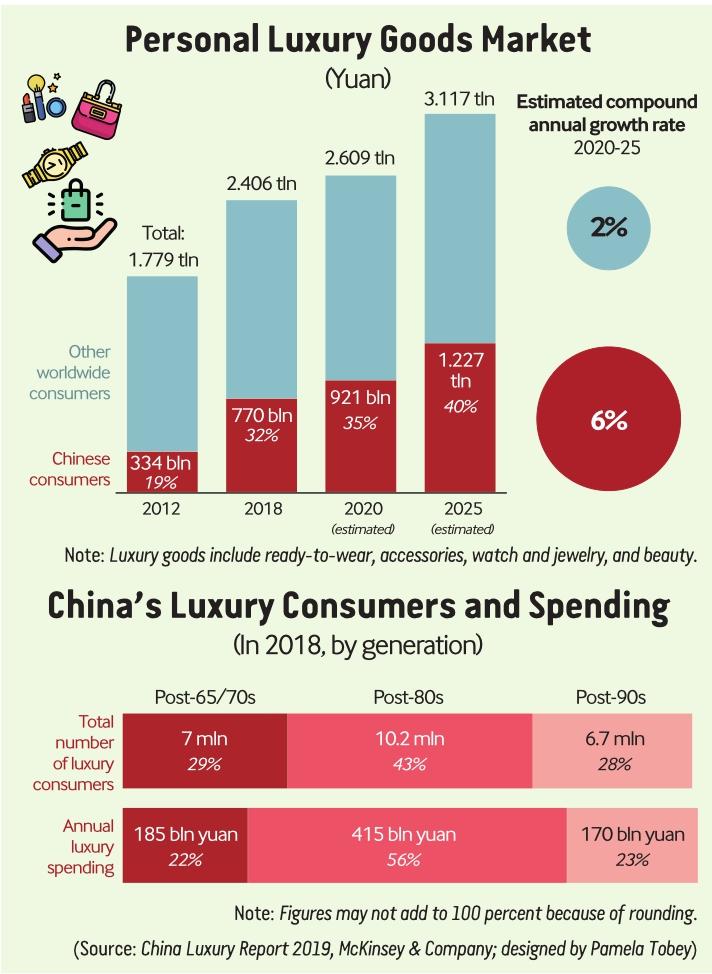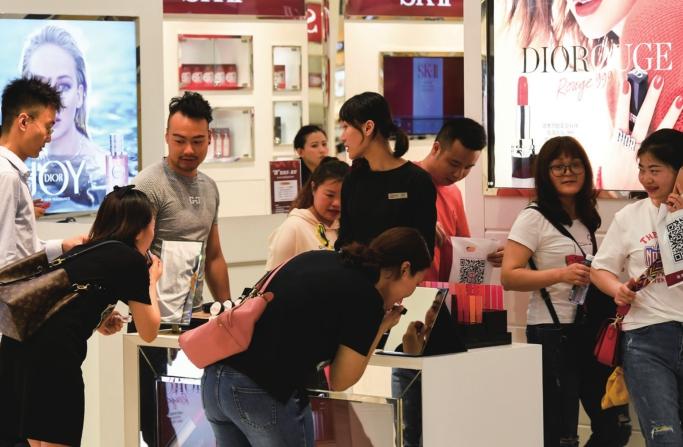Lap of Luxury
2019-06-03ByZhangShasha
By Zhang Shasha
Imagine the chemistry that occurs when big brands embrace Chinese elements. Like for instance, a Burberry scarf with the Chinese character fu emblazoned on it in vivid red to denote good fortune. Or when a well-heeled woman takes out her Estee Lauder compact to powder her nose and the case glitters with the pig drawn on it with Swarovski crystals, a special edition launched during the Chinese New Year of the Pig.
Many global brands are incorporating Chinese elements in their product designs to cater to Chinese tastes and occasions and tap the huge Chinese market.
Steadfastly in 2012-18, China accounted for more than half the global growth in luxury spending, and is expected to deliver 65 percent of the worlds additional spending heading into 2025, according to UnionPay transaction data for the McKinsey China Luxury Report 2019. Established in 2002, China UnionPay is the largest bankcard network in the world, with nearly 7.6 billion cards issued.
Such growing momentum in purchases is making all luxury brands woo the lucrative Chinese market and the thinking is that those who win Chinese consumers hearts will win the fashion battle.
Splurging trends
In 2018, Chinese consumers at home and abroad spent 770 billion yuan ($115 billion) on luxury items, equivalent to a third of the global spending, with each luxury-consuming household splurging an average of 80,000 yuan($11,635). This outlay is set to almost double to 1.2 trillion yuan ($173.5 billion) by 2025, when 40 percent of the worlds spending on luxury goods will come from Chinese consumers, according to the report.
The growth can be primarily driven by an explosion of the upper middle-income group, whose population is rising at a compound annual growth rate of 28 percent from 2018 and will do so till 2025, taking the number of people in China with a $2,600-3,900 disposable income per month per household to 350 million. In addition, Chinas affl uent population with more than $3,900 disposable income per month will almost triple to 65 million by 2025.
The report said about 70 percent of them will be doing their luxury spending overseas. One reason is that outbound travel is becoming more common for Chinese.
In 2018, a total of 149.72 million Chinese made outbound trips, up 14.7 percent from the same period last year, according to the Ministry of Culture and Tourism. The number accounted for more than 10 percent of outbound travelers around the world, based on World Tourism Organization statistics.
Another reason is the price differential resulting from Chinas import tariff regime and the brands own pricing strategies. However, the ratio may shift in favor of domestic spending as a result of measures to cut luxury import tariffs.
The import tariffs on nearly 1,500 consumer products ranging from cosmetics to household appliances were slashed on July 1, 2018. This included some luxury brands as well. French fashion house Louis Vuitton has lowered its product prices in China by 300-1,500 yuan($43.4-216.8) with an average reduction of 3-5 percent. Brands like Hermes and Gucci are also adjusting their retail prices to narrow the price gap between China and other countries and boost consumption in China.
However, the worsening trade friction between China and the United States is likely to impact the situation. After the United States increased tariffs on $200 billion worth of Chinese goods on May 10, China was forced to impose additional tariffs on $60 billion worth of U.S. products, which will go into effect on June 1.
The news stirred the stock market and some U.S. luxury brands parent companies such as Tapestry, Tiffany and L Brands saw their prices plunge by 4-7 percent.
“If the United States continues to go its own way, China will have to respond, which will seriously undermine the competitiveness of U.S. products in the Chinese market,” Guo Bin, a researcher with the Rhodium Group, an independent research provider, told Jiemian.com, an online media. “The bullying tactics the United States used in bilateral trade consultations is likely to infuriate Chinese consumers, which will undermine the development of U.S. brands in China.”
Guo said the fluctuation in capital assets and prevailing uncertainties will make both investors and consumers more cautious.
Tapping young buyers
The solid performances of international luxury brands in China are mostly attributable to the strong purchasing power of Chinese consumers, especially the younger generations who constitute the backbone force.
According to the McKinsey report, the post-80s and 90s generations together accounted for 79 percent of Chinese consumers total luxury spending in 2018. The post-80s consumers spent an average of 41,000 yuan ($5,931) per person annually—56 percent of Chinese consumers total luxury spending, while the post-90s buyers spent 25,000 yuan ($3,616)—23 percent.
“Young generations do not hesitate when they buy luxuries,” Jean-Paul Agon, Chairman and CEO of international cosmetic company LOréal, said.
The reasons for their passion for luxury goods vary. The luxury buyers were born into Chinas urban middle class and as members of a single-child generation are often showered with not only affection but financial support from their extended families, Aimee Kim, a senior partner in McKinseys Seoul offi ce, said. They are also well-educated, exposed to Western culture and grew up in a world of digital technology and social media.
“Luxury makes young consumers feel confident, sophisticated and different. It is a very powerful form of social capital for them. It also helps them to form a very close bond with their best friends in their WeChat groups,” Lan Luan, a partner with McKinsey, said, referring to the most used social media app in China.
She also said Chinese consumers are super digitally and socially connected. They get information from a large variety of sources, from online to offline, overseas to domestic. On average, luxury splurgers spend 3-5 hours a week reading about luxury items and access around 16 different information sources.
“In the past, the luxury industry was relatively closed. But in the era of the Internet, people have access to ample information, which boosts the growth of their consumption desire,” Zhou Ting, Director of Fortune Character Research Institute, a lifestyle consultant organization, told the media.
She said with the rapid development of e- commerce, demands on online purchasing have also increased, necessitating the luxury brands to innovate their ways of marketing and localization strategies.
While luxury consumers in China may get most of their information from online sources, they still buy in brick-and-mortar stores. “More than 90 percent of purchases are in fact made offline today,”Kim said. “This does not mean Chinese consumers are not ready to make the shift to digital… We expect luxury online sales to grow by two or threefold from what it is today by 2025.”
Daniel Zipser, a senior partner in McKinseys Shanghai Office, said it is a very exciting time for global luxury brands in China. “We see enormous opportunities for brands with the right strategies to capture a bigger slice of this rapidly growing market,” he added.
While brands continue to have the biggest influence on consumers making luxury purchases, Zipser added that younger consumers, however, value brand less. Some post-90s consumers even said they would be willing to try out Chinese brands.
Young consumers also trust recommendations by key opinion leaders, infl uencers, friends and family. In-store assistants play a critical role too, not only in the store, but also through social media platforms. Therefore, it is imperative for global brands to have insights into their consumers and put forward strategies accordingly.
Kim said luxury brands will need to transform their approach to product innovation and marketing and learn how to better use digital technology and data analytics to deliver the kind of brand and product experiences young Chinese luxury consumers seek.
